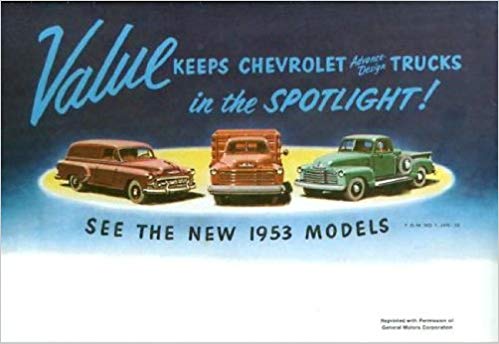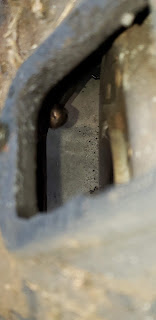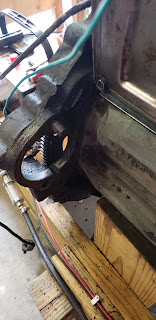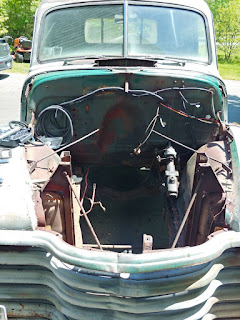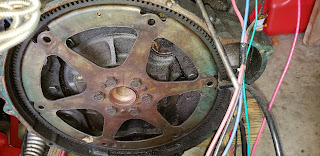Hello Gray Ghost Fans!
It has been a while. Much longer, in fact, than I thought it would be. As usual, I've got a reason. It may not be a good reason, but it's a reason just the same. So, as I mentioned in my last post, I was prepping for the big day...engine removal day! Before I got there, I wanted to get the transmission out. My logic here was that I wanted to prep the replacement engine and have it ready for the day that I did the old engine removal. My naivete had me believing that I could get the old one out and at least install the new one on the same day. Of course, I'd need a couple of days to make all the connections, add fluids, etc to make the engine move the truck, but just one day to swap engines.... (This literary and film fans is what's known as foreshadowing.) Anyway, back to the transmission removal.
So on one of my days off, I took the page from the 1953 shop manual and headed out to the garage. I'd already done some cleaning of the torque tube, knowing that the shop manual instructs you to unbolt the transmission collar and slide it to the rear of the space provided. The cleaned up tube with the collar unbolted looked like this:

In this shot you can see the torque tube, collar, universal ball and transmission cross member. Also, a 2x4 block on the floor jack to support it, since it is under tension from the suspension. Next, I needed to slide the universal ball backward, exposing the universal joint. Then, you unbolt the universal joint and slide the internal workings as far backward as possible. So far, so good. I was a bit uneasy about being under the torque tube as it will crash to the floor if the bracing failed. It would have enough force to do bodily harm...or worse. So I worked slowly and carefully and got the universal joint unbolted and the internals moved backward. Next, you need to jack up the torque tube until it touches the underside of the cab floor and insert a 2x4 cut to fit between the frame rails. Then you can safely lower the torque tube until it rests on the 2x4. All of that I accomplished. Things are going along swimmingly. At this point, it's time to turn my attention to the transmission.
In preparation for doing this work, I had to make an old tool that the shop manual calls out. In reality, it's nothing more than some modified bolts. So, once I figured out the right size bolt, it was off to the home store and then to the work bench. The bolts started like this:
And ended up looking like this:
What you end up doing is removing the top two bolts that hold the transmission to the bellhousing and screwing in the modified bolts. They act as pins that the transmission hangs off while you remove the two bottom bolts. So, armed with my rendition of a 1953 Chevy tool, it was back under the truck. Bolt #1 out, pin #1 in: bolt #2 out, pin #2 in. It seems to be working rather well.
Now that the transmission is hanging by the two pins, it's time to slide it backward, off of the pins, past the end of the torque tube that is propped up by the 2x4 and out from under the truck. But wait. It weighs 60-70 lbs. I can't just lay on my back and "bench press" my transmission. What to do? I know, I have an old floor jack that had a slow leak, so I couldn't really use it to jack things up. I'll buy a transmission adapter and modify the floor jack to be a transmission jack. Off to eBay!
Time passes and my adapter arrives. Well, apparently, I didn't quite understand how these things work and it wasn't really meant for my kind of floor jack. So time for some backyard mechanic engineering. I ended up having to modify the transmission adapter and add hardware (nuts and bolts) to make it fit. Some of the pics showing the process follow:
The original floor jack part that holds whatever you are jacking up...
The amount of the mounting tube from the transmission adapter that I had to cut off to make it sit flush in the floor jack.
Inside the transmission adapter showing the bolt that holds it to the floor jack.
Side view of the floor jack after adding the transmission jack adapter.
Full view of the floor jack after modification.
Almost looks like I knew what I was doing! Enough gloating, time to get back under the truck!
So, I'm back under the truck, I've got my handy dandy transmission jack and I'm ready to get that mother out of there! I raise the jack to meet the transmission and immediately realize that I'll need some wood blocks to help with the odd shape of the transmission. Back out from under the truck and over to the scrap bucket. Got it, now back under the truck. Blocks in place, safety chain in place, transmission properly supported, it's time to slide it backward...BONK! Bonk?!? What the heck is bonk?
Bonk is the sound the transmission makes when it impacts the torque tube.
I know what you're thinking. You raised the torque tube up and supported it with the dreaded 2x4. Bonk is not something that we should hear! Sadly, bonk is what we heard. So, back into the bellhousing it goes. Now, I'm laying on my back, hanging shop light lighting the space under the truck and staring at the torque tube. Time passes with no illuminating thoughts. Time to try again, because honestly, you probably just screwed it up, noob. Back it goes...and...BONK! Crap! Forward it goes. This sucks. I know, let's try to raise the torque tube back up the the cab floor. Remember when we lowered it to the 2x4? Maybe we should have gotten the transmission out before lowering it? Worth a try. So back to the floor jack, up goes the torque tube, back goes the transmission and...wait for it...BONK! WTFO? It's not supposed to be this way. Things were going so well! Ok, time to put it back forward. Umm, what's happening? It won't go forward anymore! Did the end get spun around so that the input shaft does not align with the clutch disk anymore?!? Oh no! I can't go forward and I can't go backward! I know, I'll try to spin the universal on purpose, maybe I can get them aligned again. Well, after several minutes of trying, I had to call "no joy" on that mission. Good grief! It (the transmission) is literally stuck halfway in and halfway out. That's it, I'm wiped out and time for calling it a day. (For clarity sake, the preceding was also spread over many days of work in the garage.)
Now I'm worried and after much thought I decided that the only thing to do was to support the transmission with the jack while I removed or at least moved forward the engine so that the input shaft would clear the bellhousing. So here it is, stuck and real life takes a priority. Knowing that I'd be tied up for several weekends, I decided to add another 2x4 brace under the transmission to support the rear of it, while the input shaft supported the front and walked away for family time. Don't get me wrong, even though I was always thinking about the situation, my family will always come first. Always. So time passed (this all started in February). March came and went. Then on to April. False start. False start again. Loads of rain on a Friday night. Youth soccer is cancelled on Saturday. It's sunny and pleasant outside. Time to get it on!
After an abortive attempt to lift the engine, with the truck still in the garage, in the beginning of the month (I left that part out above) I knew the truck had to come out for this to work. So, early that Saturday morning, I got everything out of the garage and got the truck down off of her jack stands. She had been lifted up on them for over 2 years! With my Wife behind the wheel and my Son helping me push we backed her out of the garage. Now, my wife had some nerves about doing this, since dear old me did the brake rebuild! I would say trust but verify, but we'll stick with just verify. Anyway, the brakes worked perfectly! We eased her into the driveway and onto home built chock/stands to lift her about 3" and chock the wheels so it wouldn't roll over me.
Unbolting the motor mount bolts was not difficult. Neither was attaching the engine load leveler to the hoist and engine. Time to lift! Pump the handle on the engine hoist and up she goes. Up, up, clank! You've got to be kidding me! Now what? The engine shifted rearward and banged into the firewall. Thankfully, without enough force to do any damage. Time to lift some more. Pump the handle...Big Clank! Now what??? Holy crap! The transmission is free from the bellhousing and sitting on the transmission jack!
The feeling of relief was instant. So all stop on lifting the engine time to get the transmission out from under the truck. Since the truck wasn't lifted, we needed to lower the transmission off of the jack and down to the ground. So we put down some cardboard and lowered the transmission to the ground. Once out from under the truck, it looked like this:
The transmission is laying upside down in this pic. Still you can clearly see the torque tube connection and universal joint. Now on to the engine!
With the transmission out, it was time to really get that engine up in the air. This was necessary for the engine to clear the truck's grill. But before we did that, my wife snapped a quick pick of me and my helper, my youngest son. We and the truck looked like this:

Time to get lifting! Up, up, up it goes. As you can see in the pic, we are close to the garage. We are there, because we are pushing the truck wherever it goes! So we only came out of the garage a little. Decisions have consequences.... Once the engine hoist was raised to where the engine was just clearing the grill, it was about to hit the garage door opening! OMG! What to do? We raised it literally as far as it would go and moved the hoist back towards the garage. Using the load leveler we were able to drop the front of the engine after it had cleared the grill and raise the rear. This was the most important part, as the oil pan is quite deep. Once the oil pan cleared the grill we were in a pickle. The engine, facing forward, could not be lowered as it would impact the front of the truck. We couldn't move the hoist back, because the boom was against the garage. Our solution was to rotate the engine so that it was sideways and to slowly lower it. We wouldn't have enough clearance to get it to the ground, but lowering it would buy us some overhead clearance. Once we had overhead clearance, we could move the hoist back a little, until it once again hit the overhead. Lather, rinse, repeat. Lower, move backward, lower, move backward. Eventually, we got it down and into the garage. Inside the garage me and the engine looked like this:

Under the engine you can see the dolly that I made using plans from the truck forum that I belong to. Some finagling later and the engine was down on the dolly and stowed next to the engine that will eventually get installed in the truck.
Here is the transmission on the workbench:
As you can see, it is a mess! And I wouldn't want it any other way. Why? Because under all that oily crud lies perfectly pristine cast iron. The only rust is in areas that didn't get caked in oily crud. A lot of cleaning? Absolutely! But seriously worth it. I'll get the crud off and give it a nice coat of satin black paint.
The truck? It now looks like this:
Kinda reminds me of when you lose your front teeth. You look a bit goofy, but they grow back and then you look normal again. In the meantime, I've got a ton of cleaning in the engine bay to do. It is a mess! Basically, I'm going to get a small stool and climb in the engine bay and have at it. Once the transmission and engine bay are clean, I'll move on to prepping the replacement engine for installation. Right now, the rear of that engine is set up for an automatic transmission and looks like this:
Instead of a bellhousing and flywheel, it had the automatic transmission, torque converter and flexplate. These all have to go. Remember that I have all of the parts necessary to make the conversion:
Restored bellhousing and stomp starter.
New front motor mount, painted and ready to go.
Resurfaced, original heavy duty flywheel.
In addition to these, I've got a new clutch kit, new rear motor mounts, new radiator and all of the fluids and other bits and pieces necessary to make the installation. But first, I'll fit out that engine with the parts to make it a manual transmission.
All in all it was a wonderful day. I got to spend it with one of my children, working on my truck and making real progress. It doesn't get any better than that.
Much more to come, Gray Ghost Fans. Be sure to check back throughout the summer to see if I can make any progress! That's all for now.
